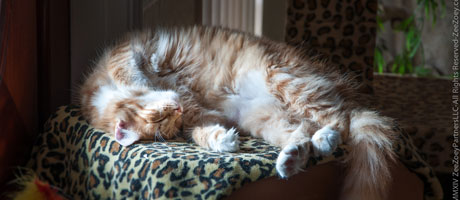Living in Comfort with Cats – 10 Tips to Managing Cat Allergies
Editor’s Note: This article was previously published. However, with it being allergy season, coupled with the fact so many cats are not adopted, or are brought to shelters because of cat allergies, it seemed prudent to share it again.
Being immersed in the world of cat blogging and advocacy, I’ve heard just about every excuse there is from those that don’t have a cat but might want one, as to why they can’t. Having a dog ranks right up there, but the most common reason is because of cat allergies. As a happy pet parent to seven cats, along with the fact millions of cats are living in shelters in need of a good home, I’d like to let you in on a couple secrets so you can adopt that adorable ball of fluff you’ve always wanted (or keep the sniffles to a minimum with the cat you already have)!
First off, for most of my life, I’ve lived in a home with both cats and dogs. At one point I had 5 dogs and 4 cats living together, so I can assure you, unless the circumstances are extreme, cats and dogs are able to get along if you’re willing to put the time and effort into making it work. My other secret – I’m allergic to cats. Or, I should say, I was allergic to cats. I made some lifestyle changes years ago and have been allergy-free ever since. The good news, with some perseverance and preventative measures, most people that are allergic to cats can manage their symptoms too.
Contrary to popular belief, cat hair itself is not allergenic. Cat allergies are caused by the Fel d 1 protein emanating from sebum found in the sebaceous glands of cats. The protein attaches itself to dried skin (dander) which flakes off and floats through the air when cats wash themselves. An allergy occurs when the body over-reacts to this substance and produces excessive amounts of histamine which leads to the irritating symptoms associated with cat-allergies – itchy eyes, sneezing, skin rash, etc.

Your cat might not always be the cause of your allergies – often it can be plant pollen or other substances in the air that are carried into your home that can trigger an allergy attack.
Ironically, it might not always be the cat that is the root cause of the allergy. Outside cats (and humans) can bring pollen, mold, and other allergens into the house, or there may be airborne allergens in the house from dust mites, carpet dust, mold spores, or pollen and chemicals in the environment that trigger allergies. Rather than assume it’s the cat, check the cat is actually the source of the allergen by getting a skin test done by an allergist. Some sufferers are successfully treated for the symptoms with allergy shots or over the counter antihistamine tablets, nasal sprays or homeopathic remedies.
If a shot or medication doesn’t do the trick, here are some other tips:
1. Remove dander from the air with strategically placed ionizers and HEPA (High-Efficiency Particulate Air) purifying systems. These units come in a variety of sizes, prices, and styles to suit your needs, budget, and home square footage.
2. Keep your cat out of any bedroom where the person is allergic and do not let them sleep on the bed. Provide other comfortable sleeping areas for him to nap and if you do allow him to sleep on the bed (for some cat lovers, it’s impossible to say no), wash all bedding in 140-degree hot water at least twice monthly. This will eliminate both dust mites and cat allergens and there are products available, such as DeMite, that can be used with the laundry detergent to kill harmful particles.
3. Keep towels and throw blankets on couches and furniture where your cat might nap so you can wash the linens frequently, and change air conditioning filters on a regular basis, as they also catch a large amount of cat hair. You can also use an anti-allergen spray to deactivate allergens. Allersearch ADS, made from plant-based, non-toxic substances, can safely be sprayed throughout the house to take the sting out of household dust by rendering allergens harmless.

To keep your cat from depositing dander on your furniture, provide her with a comfortable throw blanket to nap on that can easily be washed.
4. Carpet is a magnet for allergens, so vacuum frequently with a high-grade HEPA vacuum. Use the hand tools to get into hard to reach spaces – cat allergen particles are very small and invasive so you have to do a thorough job. This includes furniture, throw rugs, drapery, walls, under furniture, and more.
5. Hardwood and tile floors, especially in corners where cat hair tends to drift should be swept frequently. If you find your allergies are being triggered while vacuuming or sweeping, wear a protective mask to cover your nose while doing these tasks. Damp mopping these surfaces (including walls) also helps to keep dander under control. Dust frequently and use liberal amounts of spray furniture polish, as this dramatically limits allergen particles from becoming airborne.

My house was once covered in wall-to-wall carpeting. After removing it and replacing it with tiles, any allergy symptoms I had due to my cats were substantially reduced.
6. For extra cleaning, use a vapor steam cleaner. They’re an effective method to provide a chemical-free way of cleaning and killing dust mites, bacteria, mold spores, and cat allergens.
7. Wash your hands after petting your cat and avoid rubbing your eyes. Rubbing your eyes can result in itchy eyes for hours and a strong anti-bacterial soap should be used. You should also avoid excessive hugging and snugging with your cat.
8. Clean your cat. Most cats would prefer NOT to be bathed and its effectiveness isn’t entirely conclusive. As an alternative, try Allerpet, a veterinary recommended, easy to use, non-toxic liquid you apply directly to your cat’s coat to reduce allergens.
9. Use a de-shedding tool like the FURminator to regularly brush and groom your cat. This highly effective tool gets deep into the undercoat of the cat’s fur and significantly reduces shedding. Groom in a well-ventilated area so the dander dissipates.

Not only do my cats love to be groomed with the FURminator de-shedding tool, but by doing it, it greatly reduces the amount of dander in the house.
10. Dust from cleaning litter boxes can trigger allergy attacks. Either find someone who is not allergic to do the cleaning, or use a protective nose mask to reduce the chances of allergens entering your body.
One, some, or all of the above methods might be needed to keep your allergies under control. But with time, effort, and experimenting, chances are that you and your cat can co-exist peacefully together in your home and you can enjoy a long and happy relationship with your cat. Or, now that you know some tips to making your house allergen-free, you can take the plunge and adopt that cat you always wanted, but didn’t think you could have…
ALL cats produce dander, though some cats produce less than others. No cat is allergen-free, not even hairless cats, although there are some studies that conclude Rex, Sphynx, and Siberian Cats are less likely to cause allergies than others. If you do decide to look into one of these breeds, please consider finding a breed specific rescue organization or contact Petfinder.com for adoptable cats in your area.

























These are great tips – and I had no idea you were once allergic to cats!
MOL Ingrid … one of the great secrets of the cat world just revealed!!
It really upsets me when people return their cats to the shelter because they are allergic. As you’ve pointed out here, there are plenty of things you can do to reduce allergens in the air as well as medications you can take to manage symptoms. I, too, am allergic to cats, but I cannot imagine life without my babies. I let Lita and Carmine sleep on my bed and just deal with it. I sleep better with them there. 🙂
Oh gosh Fur Everywhere… I would be lost without my cats! I would never kick them off my bed, even if I was having an allergy attack! Thankfully I’ve built up an immunity and it’s no longer an issue – my cats literally sleep on my head sometimes!
Great tips ! We didn’t know some of them, good to know ! Purrs
Happy to provide you with some new tips, Swiss Cats!
Those were good and we’re quite happy nobody here is allergic!
Lucky you, Brian!!
Great post and tips, thank you! I was very allergic to cats as a teen, but look at me now! Three cats and a dog. I basically follow your tips above, although I’ve never tried or heard of Allerpet. And I really need to get a FURminator.
Thanks Three Chatty Cats – I’m glad you like the post. The FURminator is great – it’s also helpful for reducing hairballs in cats.
I, also, have been allergic to cats all my life, but I grew up with both cats & dogs. My sister, who is also allergic, & I both feel that our exposure to them has actually decreased our allergies, somewhat like the way allergy shots work, by gradually building up our immunity to the cat dander.
I also follow most of the steps you outlined above, especially my rule of washing my hands after petting the cats & before touching my face or eyes!
Thanks for a very informative article!
Hi Catherine –
Thanks for stopping by and sharing your feedback. I completely agree with you – I think as time has gone by, I built up an immunity as well. I honestly can’t remember the last time I’ve been affected by my cats. Most of my allergies stem from particular plants that bloom certain times of the year – I always keep over-the-counter medication in the house just to be safe!
EXCELLENT suggestions! In 2016, there is absolutely no reason why “allergies” should stop cats from finding loving, forever homes.
Thanks for these tips! It’s such a pity that there are a lot of allergic people out there who would love to get a cat but can’t because of allergies. In some cases, with frequent exposure to cats, the allergy can be overcome. I’ve seen this happen with friends who took the plunge and just got the cat anyway! Within six months to a year their symptoms were either bearable or have completely disappeared. On the other side of the coin, there are those who are severely allergic. Two of my rescue cats were surrendered due to cat allergies. While we don’t have allergies in our house, we would still love to get one of those HEPA air purifying systems. If you can recommend some good ones that you know of that would be great! Perhaps you have done a post about it already?
Excellent tips. Thank cod the mom isn’t allergic to cats!
Those are great tips and will definitely help with the allergies. I am so glad that you found a solution that works great. Thank you very much for stopping by the Bayou this week while I was sick. It really meant a lot to me ♥
These are great tips! My house was previously owned by someone with allergies, and the air handler for the air conditioner/furnace has a drawer-like contraption that has a huge whole-house HEPA filter on it. I didn’t even know they existed before that, but it’s great for helping with the air quality on so many levels…. and you only have to remember to change one filter for the whole house. Score one for the forgetful people.
Those are excellent tips Deb. I’ve had cat allergies since I was about 27, but I’m now on my 4th cat. For the most part I think you learn to adjust to your own pet – in other worse, your body seems to accept the dander from your own pet, but not others. i can tell immediately when around another cat – start sneezing and tearing up. I like hte idea of a HEPA vacuum cleaner too – think we’ll have to look into one of those. Thanks for a great post.
TW always wondered why her throat used to close up until she did get an allergy test and found out she was allergic to cats. Not being a candidate for shots, she started taking Benedryl daily. She also used to have ionizes in every room until she found out they were the cause for her asthma. They produce ozone and sensitive people shouldn’t go out when the ozone level is high so why bring it into the house, right? Anyhoo, we like your tips but there’s never enough time to clean.
Funny story: when TW had the air ducts cleaned, one of the men was highly allergic to cats. At first he was sneezing but then it got really scary. TW gave him a Benny and he had to step out into the hall. The cleaning was loud and scary so it served him right.
Excellent post. I had never heard of the Demite and Allersearch, those sound like good products.
Great tips! I, too, was severely allergic to cats as a child. Thank goodness I (mostly) outgrew that as an adult. 🙂
great post Deb; mom is allergic to dad…oops…..cats….. 🙂
and these tips will come in handy; thanx for sharing them ! ♥♥♥
I’m Allergic to animals though I have never had a problem with cats,and even though I had allergies with my previous rabbits that was mainly because of their bedding and hay.But since Having Speedy my allergies have gotten worse.You would think that it would be better with his shorter fur but no that fur gets everywhere and I mean everywhere!the house is all ways being Vacumed and it really is like a new pin.Ihave to wash my hands after handeling his hay and when I have finished cuddling Speedy I have to wash my eyes and nose out with water and then use eye drops before bed other wise I would be all puffy eyed the next day with a stuffed up nose and I do the same in the mornings too.plus I have my meds to take too.Its gotten now that all animals set me off now dogs cat you name it and this is only since having Speedy.But there is no way I would be with out him and I will never stop being pals with other animals too,I still love to cuddle my friends dogs and cats…I’ll just take my meds because I could never be without pets,xx Rachel
I’ve known several cat lovers who are allergic to cats but deal with it in whatever ways they need to, so that they can continue sharing their lives with their beloved feline family members. Thankfully, I’m not allergic myself, but if I was, nothing would keep me from loving my cats and sharing life with them!
Sharing this to social media with gratitude and hope that others will find it helpful.
Thank you so much for sharing. For some, it can be a simple adjustment to their life and they don’t even realize it. Anything we can do to help the kitties, right?
Such a great post, thanks so much fur sharing!
The P.A. runs ionizers in our house to keep the air clean, she swears by them.
Bestest purrs
Basil & CO xox
Excellent tips. I get allergy shots, even if I didn’t, I would still have lots of cats.